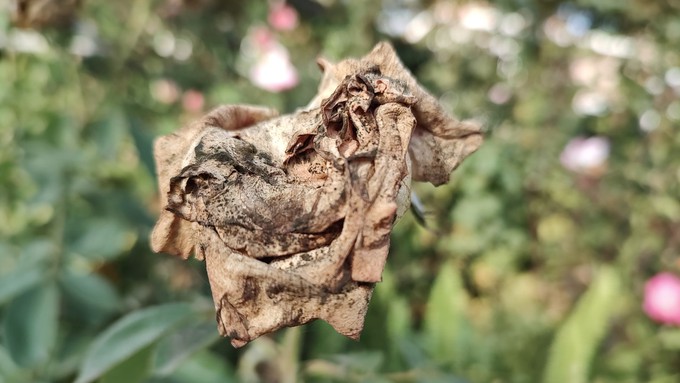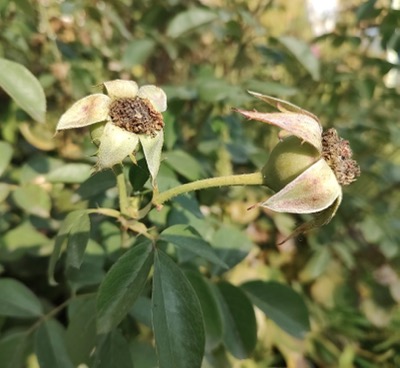
How to prevent the spread of this yucky fungal disease

Gray mold ruined this Gemini hybrid tea rose bloom. The fungus got just enough rain earlier this month to deface fall roses. Debbie Arrington
My visions of Thanksgiving bouquets are quickly turning to mush. Gray mold is attacking my roses.
Gray mold is the descriptive nickname of the fungal disease botrytis. It’s common in November rose gardens, and this season’s outbreak came early.
Damp conditions in early November gave gray mold a big boost. Gray mold – which actually looks more tan or brown on the rosebud – needs moisture for growth in plant tissues, particularly tender flower petals. And this month, the fungus got just enough rain to explode among my pretty fall roses.
Gray mold starts out looking like pink measles or brownish water spots on light-colored flowers. Those brown spots rapidly grow until the fungus consumes the whole petal and eventually the whole flower. The bud never fully opens.
Gray mold also attacks many other favorite flowers including African violet, aster, begonia, carnation, chrysanthemum, cyclamen, cymbidium, gerbera, geranium, gladiolus, hydrangea, marigold, orchid, petunia, poinsettia, primrose, ranunculus, snapdragon and zinnia.

According to UC Integrated Pest Management program, the best control of gray mold is “good sanitation.” Clip off infected blooms, put them in a plastic bag and dispose in the trash. Do not compost them; that just recycles the spores back into the garden.
Pick up fallen blooms and petals around the bush and dispose of them, too. After pruning when roses are dormant, rake out old mulch and fallen foliage. (This contains other fungal spores, too, for powdery mildew, rust, black spot and other rose diseases.) Dispose of that old mulch (again in the trash, not compost) and replace with fresh mulch.
Generally, I snip off buds infected with gray mold before they have a chance to drop. (That’s my game plan for spring botrytis outbreaks.)
But that strategy is problematic in mid-November. The bush needs its hips – the fruit located at the base of the blooms – to mature; that’s the plant’s signal to go into dormancy and shut down for the winter. If the spent flowers (and forming hips) are removed, the bush keeps on pushing out new growth. (That makes rose pruning in December and January a bigger pain.)
Master rosarian Dave Coop shared this tip on how to control botrytis while also allowing the hips to ripen. Instead of snipping off the spent bloom, gently pull off its petals. (Make sure to wear gloves when working with roses.) Discard the brown infected petals. The clean hip can then ripen, turning bright orange or red. And the bush can start shutting down for winter.
This method also helps control future fungal outbreaks. Instead of the botrytis-packed petals laying in wait under rose bushes, the gray mold is bagged up and removed from the garden; that will cut down on infections next spring – and later in the year, too. (Again, that’s “good sanitation.”)
For more information on gray mold, check out these pest notes from UC IPM: http://ipm.ucanr.edu/PMG/r280100511.html
Comments
0 comments have been posted.Sacramento Digs Gardening to your inbox.
Food in My Back Yard Series
May 6: Maintain soil moisture with mulch for garden success
April 29: What's (already) wrong with my tomato plants?
April 22: Should you stock up on fertilizer? (Yes!)
April 15: Grow culinary herbs in containers
April 8: When to plant summer vegetables
April 1: Don't be fooled by these garden myths
March 25: Fertilizer tips: How to 'feed' your vegetables for healthy growth
March 18: Time to give vegetable seedlings some more space
March 11: Ways to win the fight against weeds
March 4: Potatoes from the garden
Feb. 25: Plant a fruit tree now -- for later
Feb. 18: How to squeeze more food into less space
Feb. 11: When to plant? Consider staggering your transplants
Feb. 4: Starting in seed starting
Sites We Like
Garden Checklist for week of May 11
Make the most of the lower temperatures early in the week. We’ll be back in the 80s by Thursday.
* Plant, plant, plant! It’s prime planting season in the Sacramento area. Time to set out those tomato transplants along with peppers and eggplants. Pinch off any flowers on new transplants to make them concentrate on establishing roots instead of setting premature fruit.
* Direct-seed melons, cucumbers, summer squash, corn, radishes, pumpkins and annual herbs such as basil.
* Harvest cabbage, lettuce, peas and green onions.
* In the flower garden, direct-seed sunflowers, cosmos, salvia, zinnias, marigolds, celosia and asters. (You also can transplant seedlings for many of the same flowers.)
* Plant dahlia tubers.
* Transplant petunias, marigolds and perennial flowers such as astilbe, columbine, coneflowers, coreopsis, dahlias, rudbeckia and verbena.
* Keep an eye out for slugs, snails, earwigs and aphids that want to dine on tender new growth.
* Feed summer bloomers with a balanced fertilizer.
* For continued bloom, cut off spent flowers on roses as well as other flowering plants.
* Add mulch to the garden to maintain moisture. Mulch also cuts down on weeds. But don’t let it mound around the stems or trunks of trees or shrubs. Leave about a 6-inch-to-1-foot circle to avoid crown rot or other problems.
* Remember to weed! Pull those nasties before they set seed.
* Water early in the day and keep seedlings evenly moist.